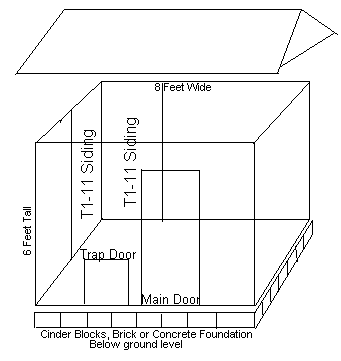This basic aviary plan is the cummulative effort of our members. Rehabilitators have a variety of preferences for the design and all the variables have been included to help you design an aviary that best fits your needs. Aviary considerations are included. As an additional option to streamline construction, you can purchase kits to help create the framework. The kits range in price from $60 to $300. Click on the images for more details.   |
 |
Location
- Select a location on your property that drains well, receives full sun and is located away from daily activity (pets, neighbors, traffic, etc). Ideally this location should be situated near areas of cover (trees, dense shrubs) to aide in releases.
- The side with T1-11 siding should be facing North-Northwest to protect against the elements. The open wire side should face South-Southeast to receive full sunlight.
- The floor of the aviary should sit 2+ inches above ground level and soil should be sloped away from it’s base to encourage good drainage.
|
Basic Design
- Minimum size should be 6’x6’x6′.
- Although a variety of roof designs can be used (hip, flat), an A-frame is more efficient for the birds and allows for a covered roosting area.
- A standard 2×4 lumber frame works well, but areas that are subject to high winds or hurricanes should anchor the corners with concreted 4×4 posts.
- A 12″ underground perimeter foundation is necessary to prevent access by burrowing predators.
|
Doors
- The type of doors are based on preference.
- Use of trap doors are recommended to facilitate providing fresh food/water without risking bird escapes. They can also be used for slow releases and re-entry if risk of predator entry is low during release period.
- A pre-entry area can be added to the main door to further prevent bird escapes while entering the aviary.
- “Hack” doors can be built higher in the walls or roof for releases.
|
Substrate
- If using soil, it should drain well and not have a high clay ratio. Most literature requires soil substrates be tilled and disinfected a minimum of 2 times per year, or more frequently as needed.
- If using concrete, large shallow containers of soil should be available inside the aviary.
|
Wire
- 1/4 inch hardware cloth is preferred.
- Some rehabiitators add a liner to the inside of the wire to prevent feather damage.
- Ledges or perches that directly contact wire should have a liner at the contact point to prevent feather damage.
|
Perches
- Free-standing ladder or hanging perches
- Roosting ledges should be available for doves and pigeons
- Ladder perches should be available for flight-compromised birds
- Perches should all be positioned in one direction opposing one another, to encourage cross flight instead of “hopping”.
- Ledges or perches that directly contact wire should have a liner at the contact point to prevent feather damage.
- Bamboo reeds (invasive plants that grow rampantly in many forested areas), have few “catch” areas and are less likely to accummulate buildup or harbor bacteria than natural wood branches.
|
Accessories
- Logs should be securely hung in opposing corners for woodpeckers and like species.
- Ground cover plants such as Liriope or Monkey Grass should be situated near the T1-11 side as cover for reclusive species (Rails, Woodcocks) and gamebirds.
- A medium potted shrub (Privet or comparable) should be made available when housing smaller species (finches, warblers).
- Luxury: A misting line running around the inside perimeter.
|